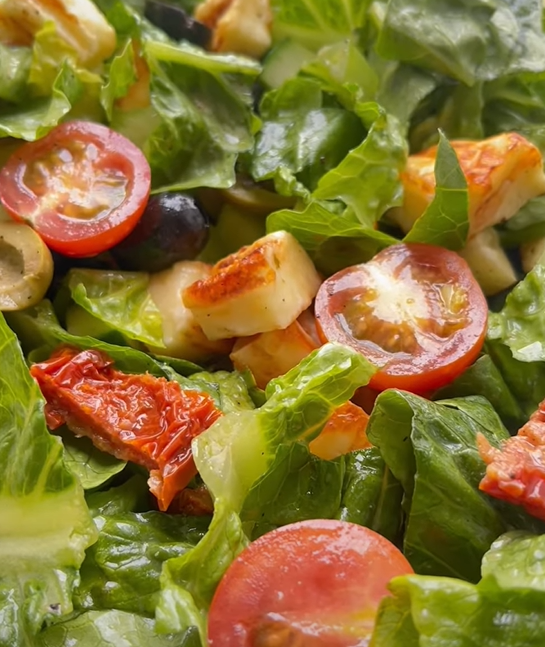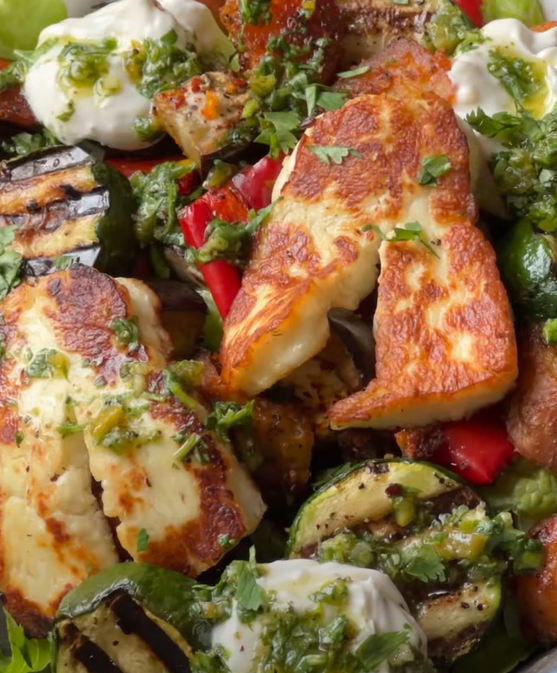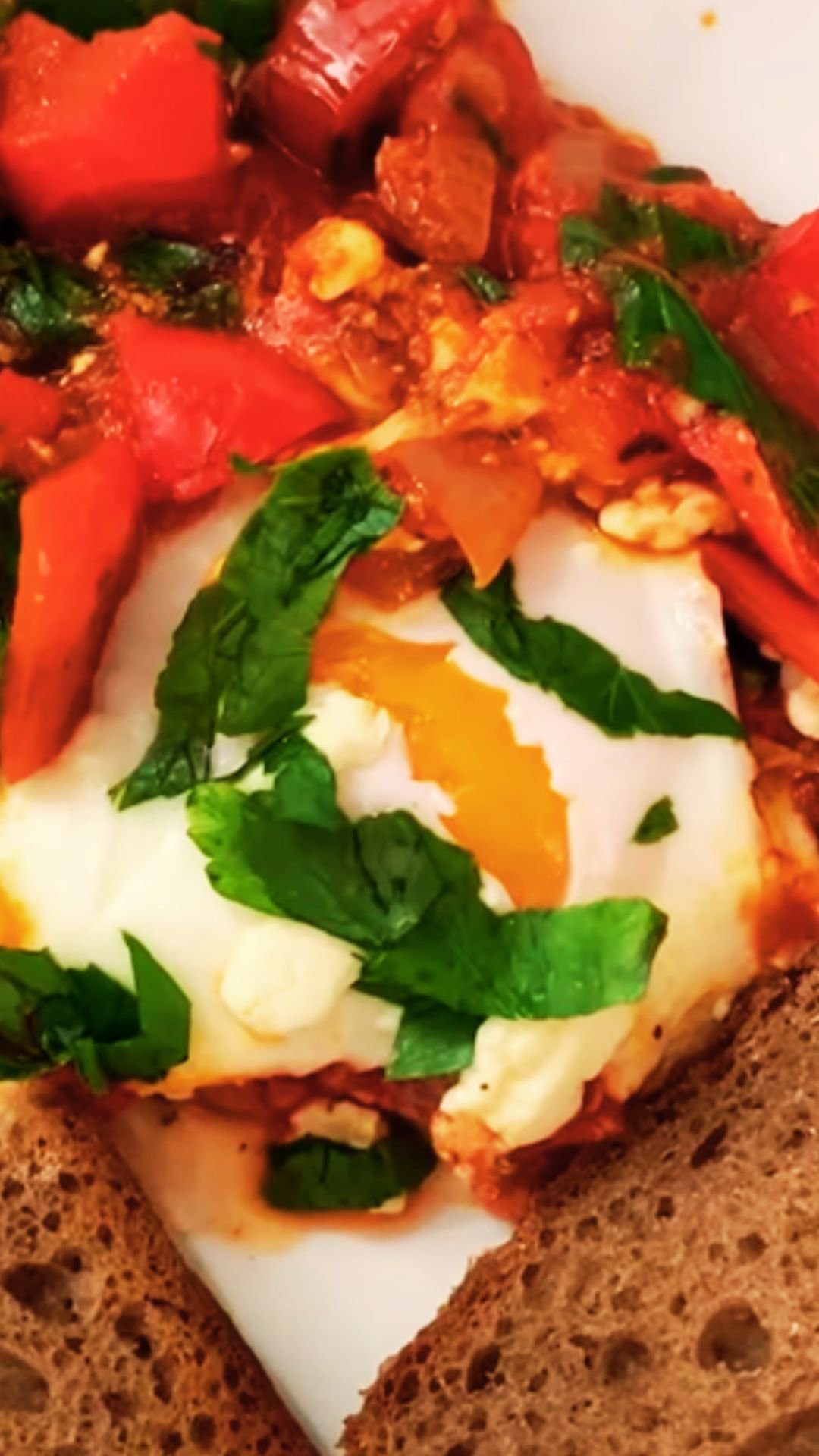I’ve always believed that breakfast should be more than just fuel for the day—it should be an experience that awakens your senses and sets a positive tone for everything that follows. That’s exactly what my halloumi breakfast bowl with salad delivers: a perfect harmony of crispy, golden cheese, fresh vegetables, and vibrant flavors that transform your morning routine into something truly special.
When I first discovered the magic of combining halloumi with fresh salad greens for breakfast, it completely changed my perspective on morning meals. This isn’t your typical cereal-and-toast affair. Instead, it’s a nutritious, protein-packed bowl that satisfies your hunger while providing sustained energy throughout the morning. The beauty of this dish lies in its versatility—you can customize it based on seasonal ingredients, dietary preferences, or simply what you have available in your refrigerator.
What Makes Halloumi the Perfect Breakfast Cheese
Halloumi: A semi-hard, unripened cheese traditionally made from a mixture of goat’s and sheep’s milk, though cow’s milk versions are now common. Originating from Cyprus, halloumi is known for its unique ability to hold its shape when heated and its characteristic squeaky texture.
Grilling Properties: Unlike most cheeses that melt completely when heated, halloumi maintains its structure due to its high melting point, making it ideal for grilling, frying, or broiling.
Nutritional Profile: Rich in protein, calcium, and phosphorus, halloumi provides essential nutrients that support bone health and muscle function.
The reason I’m so passionate about using halloumi in breakfast bowls is its incredible versatility. When you pan-fry or grill halloumi, it develops a gorgeous golden crust while maintaining a tender, slightly chewy interior. This textural contrast adds sophistication to what might otherwise be a simple salad, elevating it to restaurant-quality status right in your own kitchen.
Essential Ingredients for the Perfect Bowl
Creating the ideal halloumi breakfast bowl requires careful selection of ingredients that complement each other in both flavor and nutrition. I’ve spent countless mornings experimenting with different combinations, and I can confidently say that the following ingredients create the most satisfying and well-balanced bowl.
Core Components
Fresh Halloumi Cheese: Look for authentic halloumi from Cyprus or high-quality alternatives from reputable dairy producers. The cheese should feel firm to the touch and have a clean, slightly salty aroma. I prefer using approximately 100-150 grams per serving, which provides substantial protein without overwhelming the other flavors.
Mixed Greens Base: I typically combine baby spinach, arugula, and mixed lettuce for optimal flavor complexity and nutritional diversity. The peppery bite of arugula balances beautifully with the mild saltiness of halloumi, while spinach adds essential iron and folate.
Cherry Tomatoes: These little gems provide natural sweetness and acidity that cuts through the richness of the cheese. I prefer using a mixture of colors—red, yellow, and orange—for visual appeal and subtle flavor variations.
Cucumber: Adds essential crunch and freshness to the bowl. I like to use English cucumbers for their thin skin and minimal seeds, though regular cucumbers work perfectly well when peeled and deseeded.
Red Onion: Just a small amount provides sharp flavor that enhances all the other ingredients. I slice mine paper-thin and sometimes soak it briefly in cold water to mellow the intensity.
Detailed Nutritional Breakdown
Understanding the nutritional value of your breakfast helps you make informed choices about your daily diet. Here’s a comprehensive breakdown of the nutritional benefits you’ll receive from a typical halloumi breakfast bowl:
| Nutrient | Amount per Serving | % Daily Value | Health Benefits |
|---|---|---|---|
| Protein | 28-32g | 56-64% | Muscle maintenance, satiety, metabolic support |
| Calcium | 680-750mg | 68-75% | Bone health, muscle function, nerve transmission |
| Vitamin K | 145-180μg | 120-150% | Blood clotting, bone metabolism |
| Vitamin A | 2,800-3,200 IU | 56-64% | Eye health, immune function |
| Folate | 65-85μg | 16-21% | DNA synthesis, red blood cell formation |
| Iron | 3.2-4.1mg | 18-23% | Oxygen transport, energy production |
| Fiber | 4-6g | 16-24% | Digestive health, blood sugar regulation |
| Potassium | 580-650mg | 12-14% | Heart health, blood pressure regulation |
Step-by-Step Preparation Guide
The key to a perfect halloumi breakfast bowl lies in proper timing and technique. I’ve refined my method over hundreds of morning preparations, and I’m excited to share these details that will ensure your success every time.
Preparation Phase
Begin by removing your halloumi from the refrigerator about 15 minutes before cooking. This allows it to come closer to room temperature, ensuring more even cooking and better texture. While the cheese is tempering, wash and thoroughly dry your greens. I cannot emphasize enough how important it is to dry your greens completely—excess moisture will dilute your dressing and make the entire bowl soggy.
Cut your cherry tomatoes in half to release their juices, which will naturally enhance your dressing. Slice your cucumber into half-moons, keeping them about ¼-inch thick for optimal crunch. For the red onion, aim for paper-thin slices that will distribute evenly throughout the bowl without overwhelming any single bite.

Cooking the Halloumi
This is where the magic happens, and proper technique makes all the difference. Slice your halloumi into ½-inch thick pieces—this thickness ensures you get a beautiful golden crust while maintaining a tender interior. Heat a non-stick or well-seasoned cast-iron pan over medium heat. The key here is not to use too high heat, which would burn the outside before the inside warms through.
Add just a thin film of olive oil to the pan. Halloumi contains enough natural fats that you don’t need much additional oil. Place the halloumi slices in the pan, making sure not to overcrowd them. You should hear a gentle sizzle—if it’s aggressively sputtering, your heat is too high.
Cook for 2-3 minutes on the first side without moving the pieces. This allows that gorgeous golden crust to develop. Flip carefully and cook for another 1-2 minutes on the second side. The finished halloumi should be golden brown with slightly crispy edges and a warm, tender interior.
Assembly Techniques
Assembly order matters more than you might think. Start with your greens as the foundation—they provide structure and absorb flavors from the other ingredients. Arrange your tomatoes and cucumber strategically, distributing them evenly for balanced flavor in every bite.
Place the warm halloumi on top while it’s still hot from the pan. The residual heat will slightly wilt the greens beneath, creating an appealing textural contrast. Scatter the red onion slices over everything, and finish with your chosen dressing.
Dressing Variations and Flavor Profiles
The dressing can make or break your halloumi breakfast bowl, and I’ve developed several variations that each bring something unique to the table. Here’s my collection of tried-and-true dressing recipes that perfectly complement the saltiness of halloumi and freshness of the vegetables.
Classic Mediterranean Vinaigrette
This is my go-to dressing that never fails to impress. Whisk together 3 tablespoons of extra virgin olive oil, 1 tablespoon of red wine vinegar, 1 teaspoon of Dijon mustard, 1 minced garlic clove, ½ teaspoon of dried oregano, and salt and pepper to taste. The mustard acts as an emulsifier, creating a smooth, cohesive dressing that clings beautifully to the greens.
Lemon Herb Dressing
For a brighter, more citrusy approach, combine 3 tablespoons of olive oil with the juice and zest of half a lemon, 1 tablespoon of fresh chopped herbs (I love a combination of parsley, dill, and mint), 1 teaspoon of honey, and seasoning. This dressing is particularly wonderful in summer when fresh herbs are abundant.
Balsamic Reduction Drizzle
When I want something more elegant, I prepare a simple balsamic reduction by simmering ½ cup of balsamic vinegar until it reduces to about 2 tablespoons of syrupy consistency. This concentrated flavor bomb adds sophisticated sweetness that pairs beautifully with the salty halloumi.
Seasonal Adaptations and Ingredient Substitutions
One of the aspects I love most about this breakfast bowl is how easily it adapts to seasonal ingredients and dietary restrictions. Throughout the year, I modify the basic recipe to take advantage of what’s fresh and available, creating endless variety in my morning routine.
Spring Variations
During spring, I incorporate fresh asparagus spears (lightly blanched), baby peas, radish slices, and fresh herbs like chives and dill. The tender vegetables of spring require minimal preparation and add delicate flavors that don’t compete with the halloumi.
Summer Abundance
Summer is when this bowl truly shines. I add fresh corn kernels (raw or lightly grilled), bell pepper strips, fresh basil leaves, and sometimes even fresh berries for unexpected sweetness. The high water content of summer vegetables helps balance the richness of the cheese on hot mornings.
Fall Comfort
As temperatures cool, I incorporate roasted butternut squash cubes, toasted pumpkin seeds, dried cranberries, and heartier greens like kale or Swiss chard. These additions make the bowl more substantial and warming, perfect for crisp autumn mornings.
Winter Warmth
During winter months, I often add roasted root vegetables like carrots and beets, pomegranate seeds for color and antioxidants, and nuts like walnuts or pecans for extra richness and protein.
Advanced Preparation Techniques
After years of making this breakfast bowl, I’ve developed several advanced techniques that elevate the dish from good to extraordinary. These details might seem minor, but they make a significant difference in the final result.
Marinating the Halloumi
For extra flavor depth, I sometimes marinate halloumi slices for 30 minutes to 2 hours before cooking. A simple marinade of olive oil, lemon juice, minced garlic, and herbs infuses the cheese with additional complexity. Just pat the cheese dry before cooking to ensure proper browning.
Compound Butter Finishing
Occasionally, I finish the cooked halloumi with a small amount of herb compound butter. Mix softened butter with minced fresh herbs, lemon zest, and a pinch of black pepper. Add just a small amount to the warm halloumi for an extra layer of richness.
Temperature Contrasts
Playing with temperature contrasts adds sophistication to the bowl. Sometimes I serve the warm halloumi over chilled greens, or I might warm some of the vegetables slightly while keeping others completely fresh. These temperature variations create interesting textural experiences.
Troubleshooting Common Issues
Through my experience making hundreds of these bowls, I’ve encountered and solved various common problems that home cooks often face. Here are the most frequent issues and my proven solutions:
Problem: Halloumi becomes rubbery or tough Solution: This usually happens when the heat is too high or the cooking time is too long. Cook over medium heat for shorter periods, and remember that halloumi continues cooking slightly after you remove it from the pan.
Problem: Greens become wilted and soggy Solution: Ensure greens are completely dry before assembly, and add dressing just before serving. If you’re meal prepping, store dressing separately and add it when ready to eat.
Problem: Flavors don’t meld well together Solution: Let the assembled bowl sit for 5-10 minutes before eating. This allows the flavors to marry and the warm halloumi to slightly wilt the greens beneath it.
Problem: Bowl lacks visual appeal Solution: Pay attention to color distribution and height variation. Use ingredients of different colors and textures, and don’t flatten everything down—create some height and visual interest.
Meal Prep and Storage Strategies
For busy individuals who want to enjoy this nutritious breakfast throughout the week, proper meal prep techniques are essential. I’ve developed a system that allows you to prepare most components in advance while maintaining freshness and quality.
Component Preparation Schedule
Sunday: Wash and dry all greens, store in airtight containers with paper towels to absorb excess moisture. Prepare any roasted vegetables that will be used throughout the week.
Daily Fresh Components: Cut tomatoes and cucumber fresh each morning, as they release moisture over time and can make stored components soggy.
Halloumi Preparation: Cook halloumi fresh each morning for best texture and flavor. It only takes 5 minutes and makes a significant difference in quality.
Dressing Storage: Most dressings keep well in the refrigerator for up to one week. Store in glass jars and shake well before using.
Serving Suggestions and Complementary Items
While the halloumi breakfast bowl is satisfying on its own, certain accompaniments can enhance the overall breakfast experience without overwhelming the main dish.
Bread Accompaniments
A slice of toasted whole grain bread or a warm pita triangle can be wonderful for those who want additional carbohydrates. I particularly enjoy sourdough toast rubbed with a cut garlic clove and drizzled with olive oil.
Beverage Pairings
Fresh orange juice provides vitamin C and complements the Mediterranean flavors beautifully. Greek yogurt smoothies with fresh fruit offer additional protein and probiotics. Herbal teas like chamomile or mint cleanse the palate and aid digestion.
Additional Protein Options
For those with higher protein needs, a soft-boiled egg nestled on top of the bowl adds richness and visual appeal. The runny yolk creates a natural sauce that enhances all the other flavors.
Nutritional Optimization Strategies
To maximize the nutritional benefits of your halloumi breakfast bowl, consider these evidence-based optimization strategies that I’ve researched and implemented over time.
Enhancing Nutrient Absorption
Pairing vitamin C-rich tomatoes with iron-rich spinach enhances iron absorption. Adding a small amount of healthy fat (like olive oil in the dressing) improves absorption of fat-soluble vitamins A, D, E, and K present in the vegetables.
Balancing Macronutrients
While halloumi provides excellent protein, adding nuts or seeds can provide healthy omega-3 fatty acids and additional protein. Pumpkin seeds, sunflower seeds, or chopped walnuts work particularly well.
Managing Sodium Content
Halloumi is naturally high in sodium, so be mindful of additional salt in your dressing and other components. Emphasize herbs, lemon juice, and other sodium-free flavor enhancers to keep total sodium intake reasonable.
Cultural Context and Recipe Origins
Understanding the cultural background of halloumi adds depth to your appreciation of this breakfast bowl. Traditional Cypriot cuisine often features halloumi in simple preparations that highlight the cheese’s unique qualities, and my breakfast bowl adaptation honors this tradition while adding modern nutritional awareness.
The combination of fresh vegetables with cheese reflects the Mediterranean diet’s emphasis on fresh, local ingredients prepared simply to showcase their natural flavors. This approach aligns perfectly with contemporary understanding of healthy eating patterns that emphasize whole foods and minimal processing.
Questions and Answers
Q: Can I use other types of cheese instead of halloumi? I’ve experimented with various cheese alternatives, and while halloumi is unique in its grilling properties, you can substitute with paneer, which has similar heat resistance. Feta can work but will be much softer and more crumbly. Firm tofu seasoned with nutritional yeast offers a vegan alternative, though the texture will be quite different.
Q: How long can I store prepared components in the refrigerator? Washed and dried greens stay fresh for 4-5 days when stored properly with paper towels in airtight containers. Cut vegetables like tomatoes and cucumbers are best used within 2 days. Cooked halloumi should be consumed immediately for best texture, though it can be stored for 2 days and gently rewarmed.
Q: Is this breakfast bowl suitable for meal prep? Yes, but with modifications. Prepare and store components separately, assembling fresh each morning. Never store dressed salad overnight, as it becomes soggy. The beauty of this bowl is that assembly takes less than 5 minutes when components are prepped.
Q: Can I make this bowl vegan? Absolutely! Replace halloumi with seasoned and grilled firm tofu or tempeh. You can also use vegan halloumi alternatives that are becoming more widely available. Nutritional yeast in the dressing adds a cheese-like flavor that many find satisfying.
Q: What’s the best way to achieve the perfect golden crust on halloumi? The key is proper heat control and patience. Use medium heat, ensure your pan is properly heated before adding the cheese, and resist the urge to move the pieces too quickly. Let each side develop a crust for 2-3 minutes before flipping. A non-stick or well-seasoned pan prevents sticking and promotes even browning.
Q: How do I prevent the salad from becoming soggy? Thoroughly dry your greens after washing, add dressing just before serving, and consider serving components separately if you’re not eating immediately. The warm halloumi will naturally wilt some greens, which is desirable, but excess moisture from wet vegetables or too much dressing will make everything unappealingly soggy.
Q: Can I prepare this bowl the night before? While I don’t recommend assembling the complete bowl overnight, you can prep most components the evening before. Store greens, cut vegetables, and prepared dressing separately. Cook the halloumi fresh in the morning for best results, as it only takes a few minutes and makes a significant difference in texture and flavor.
Q: What wine would pair well with this breakfast bowl? For morning consumption, I’d suggest focusing on non-alcoholic beverages that complement the Mediterranean flavors. Fresh orange juice, herbal teas, or sparkling water with lemon work beautifully. If you’re serving this as a brunch dish later in the day, a crisp white wine like Sauvignon Blanc or a light rosé would complement the fresh vegetables and creamy cheese nicely.
This halloumi breakfast bowl with salad represents everything I love about Mediterranean-inspired cuisine: simplicity, freshness, and the ability to transform basic ingredients into something truly special. Every time I prepare this bowl, I’m reminded that the best meals often come from the most straightforward combinations of high-quality ingredients prepared with care and attention to detail. Whether you’re looking to upgrade your morning routine or impress guests at a weekend brunch, this versatile and nutritious bowl delivers satisfaction that extends far beyond the last bite.


